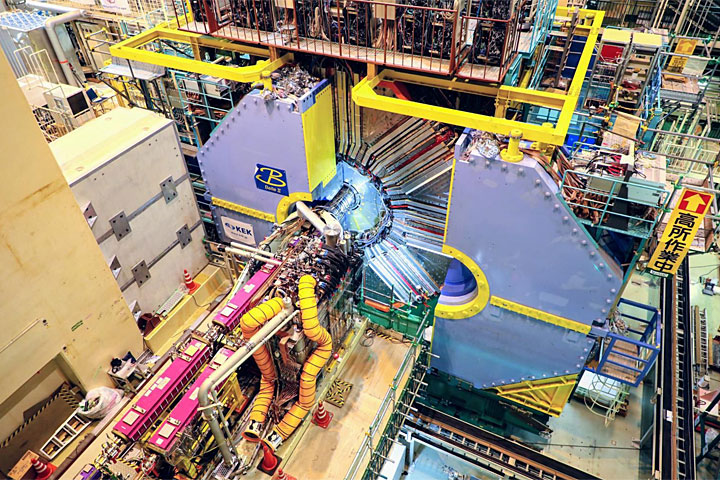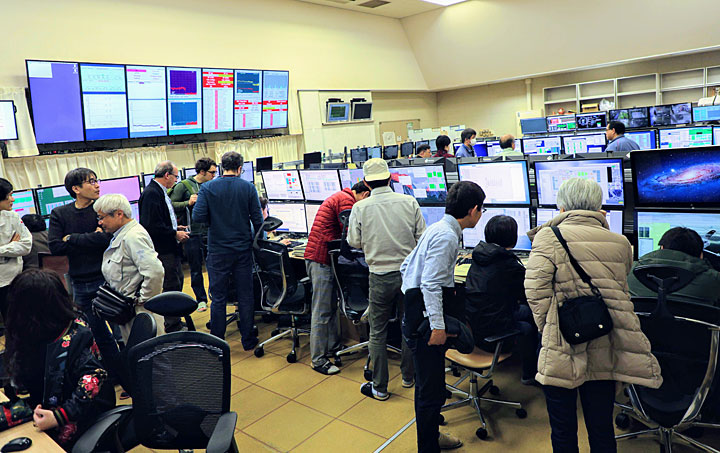SuperKEKB Phase 3 (Belle II Physics Run) Starts
March 13, 2019

SuperKEKB accelerator and Belle II detector at the interaction region. Credit: Belle II/KEK
The following news release was issued by the High Energy Accelerator Research Organization, known as KEK, in Japan, home of the Belle II experiment. The U.S. Department of Energy’s Brookhaven National Laboratory provides the U.S. portion of the computing and data storage required for the Belle II experiment, taking advantage of the excellent capabilities of the Scientific Data Computing Center as demonstrated with the ATLAS and RHIC experiments. Raw data from Belle II will be transferred to Brookhaven Lab where it will be archived for safe-keeping, calibrated, and processed into a physics-ready data format. From there, scientists at Brookhaven will distribute the physics-ready data worldwide, enabling research by Brookhaven Lab physicists and Belle II collaborators around the world. In addition, Brookhaven Lab's Superconducting Magnet Division built superconducting corrector magnets as part of the SuperKEKB upgrade to enable the improved luminosity. For more information about Brookhaven’s role in this work, contact Karen McNulty Walsh, kmcnulty@bnl.gov, (631) 344-8350.
On March 11th, 2019, Phase 3 operation of the SuperKEKB project began successfully, marking a major milestone in the development of Japan’s leading particle collider. This phase will be the physics run of the project, in which the Belle II experiment will start taking data with a fully instrumented detector.
The KEKB accelerator, operated from 1999 to 2010, currently holds the world record luminosity for an electron-positron collider. SuperKEKB, its successor, plans to reach a luminosity 40 times greater over its lifetime.
Belle II and SuperKEKB are poised to become the world’s first Super B factory facility. Belle II aims to accumulate 50 times more data than its predecessor, Belle, and to seek out new physics hidden in subatomic particles that could shed light on mysteries of the early universe.
Progress
The Belle experiment, which completed data taking in 2010, along with its competitor in the United States BaBar, demonstrated Charge-Parity Violation (CPV) in weak interactions of B mesons. This discovery was explicitly recognized by the Nobel Foundation and resulted in the 2008 Nobel Prize for Physics being awarded to Professors Makoto Kobayashi and Toshihide Maskawa for their work developing the theory of CPV in weak interactions.
A major upgrade, the Belle II/SuperKEKB facility, began construction at the end of 2010. SuperKEKB will achieve its goal of 40 times KEKB’s luminosity by shrinking the beams to “nano-beam” size, at the collision point, 20 times smaller than the beam sizes achieved at KEKB while simultaneously doubling the beam currents. These changes will result in much larger quantities of data as well as greater beam backgrounds. Belle II was designed to handle these conditions.
In February 2016, Phase 1 commissioning of the SuperKEKB accelerator was successfully completed. Low-emittance Ampère-level beams were circulated in both rings, but no collisions were possible. This was followed by the installation of the superconducting final focus magnets and the Belle II outer detector. Phase 2, the pilot run of Belle II, began in March of 2018, with the first collisions recorded in the early hours of April 26th. Initial results from Phase 2 were shown at international conferences in 2018.
For Phase 3, installation of the full decay VerteX Detector (VXD) was completed. With this change, Belle II is now fully equipped and ready to take physics data.
The Goal of Belle II
The purpose of the upgraded Belle II experiment is to search for new physics phenomena that cannot be explained by the Standard Model of Particle Physics while making precision measurements of known phenomena. Electron-positron collisions produce large quantities of B meson pairs in a clean environment with no other accompanying particles. These decays can be studied to find deviations from the accepted theory. If statistically significant differences are found, this would be one of the first discoveries of new physics since the Standard Model was developed in the 1970’s.
In order to confirm such a discovery, many times more B pairs must be observed than have ever been produced in past electron-positron facilities. To make this possible, Belle II plans to become the world’s first super B Factory, creating about 50 times the number of events of the original Belle experiment, which itself produced 760 million such events.
Background Information
All visible matter in the universe is made up of atoms, which are composed of a nucleus and surrounding electrons. Nuclei are gatherings of protons and neutrons, collectively known as nucleons, which are themselves made of smaller particles called quarks. The current understanding of elementary particle physics is that quarks, along with leptons such as electrons and neutrinos, are indivisible “elementary particles” — that is, the smallest units possible than cannot be further broken down.
In addition to quarks and leptons, there also exist particles known as “force carriers” that mediate the interactions between elementary particles, which give rise to the electromagnetic force as well as the strong and weak forces. The Higgs particle, discovered in 2012 at CERN and recognized by the 2016 Nobel Prize in Physics, is connected to the mechanism that imparts mass to elementary particles. Gravity is also thought to be carried by a force carrier that has yet to be directly detected.
Quarks cannot exist alone, always appearing either in pairs or groups of three. Particles composed of three quarks, such as protons and neutrons, are known as baryons, and quark pairs are known as mesons.
The behavior of these elementary particles and forces is described in the Standard Model of Particle Physics (SM). However, it is well known that the SM is incomplete; phenomena outside the scope of the theory still exist, such as the predominance of matter over antimatter and the existence and nature of dark matter and dark energy. In order to gain a full picture of the nature of the universe and physical laws, it is necessary to investigate physics Beyond the Standard Model (BSM).
In recent years, there has been a great deal of excitement worldwide about a number of hints of new physics in B physics. Belle II will accumulate enough data to either confirm or rule out these possibilities over the coming decade.
Explanation of Belle II Terminology
SuperKEKB accelerator
SuperKEKB is Japan’s largest electron-positron collider, built 11 meters underground on the KEK Tsukuba Campus. The circumference of each ring is about 3 km. The beams collide with a total energy of about 10.5 billion electron-volts (GeV, or Giga electron-volts). The beams are asymmetric in order to produce decay particles that fly out after they are produced and can thus be tracked. Each of the beams will also see its design current approximately doubled, from 1.8 Ampères (A) to 3.6 A for the positron beam and 1.4 A to 2.6 A for the electron beam.
Belle II detector
The Belle II detector is a very large detector surrounding the collision point of the SuperKEKB accelerator. Belle II is about 8 meters in length, width, and height respectively, and weighs 1,400 tons. The purpose of this detector is to measure the trajectories of particles produced by meson decays, and to identify the types of these particles and reconstruct their energies and momenta. It is similar to a digital camera that measures all relevant information about particle decays.
The Belle II collaboration
Belle II is an international collaboration with approximately 900 researchers from 26 countries and regions around the world, including Japan, Asia, Oceania, Europe, the United States, Russia and the Middle East. Researchers collaborate on the design, assembly, testing and commissioning of subdetectors and experimental operation. Physics data analysis will be performed by a distributed computing network with national laboratory and university computer systems around the world, centering on KEK’s Computing Research Center.
Luminosity
Luminosity is an indicator of how many particles can collide with each other in the beams. Multiplying luminosity by the “cross section” of particle interaction gives the total number of interactions created per unit time. The KEKB accelerator holds the world record for electron-positron luminosity of 2.1 × 1034 cm-2 s-1, and SuperKEKB aims to reach 80 × 1034 cm-2s-1.
Vertex Detector (VXD)
The VerteX Detector (VXD) system of Belle II is fundamental to the reconstruction of the vertex of B-meson decays. It consists of two inner layers of a silicon PiXel Detector (PXD), realized with sensors only 75 micrometers thick, followed by four layers of a Silicon Vertex Detector (SVD), which is composed of double-sided silicon strip sensors and is realized with an innovative “Origami” technique that allows placement of the readout electronics in the active volume, on top of the sensors. The assembly of this state-of-the-art tracking device took ten years and the effort of more than 150 people at eight different assembly sites spread all over the world.
Beam Background Detectors(BEAST)
BEAST refers to the group of detectors situated close to the SuperKEKB interaction point that measures beam backgrounds in situ during beam commissioning. Each detector is specifically designed to measure an individual background component, such as backgrounds arising from SuperKEKB beam injections, fast or thermal neutrons, or radiation dose incident on Belle II. The remaining BEAST detectors and their measurements are being used to understand and improve beam conditions, reduce backgrounds in Phase 3, and to ensure the protection and longevity of Belle II detectors for the full planned lifetime of Belle II.
Contact information
Research contacts
Prof. Yutaka Ushiroda
Institute of Particle and Nuclear Studies (IPNS), KEK, Japan
yutaka.ushiroda@kek.jp
Prof. Kazunori Akai
Accelerator Laboratory, KEK, Japan
akai@post.kek.jp
Press contacts in Japan
Hajime Hikino
KEK Public Relations Office
Tel: +81-29-879-6047
press@kek.jp
Prof. Toru Iijima
Belle II Outreach coordinator, Nagoya University Kobayashi-Maskawa Institute
iijima@hepl.phys.nagoya-u.ac.jp
Related Images
These and additional images are available at the KEK Public Image Archive, for use with appropriate credit.
2019-14451 | INT/EXT | Newsroom










